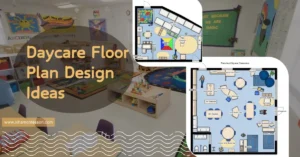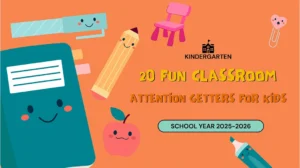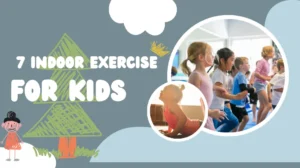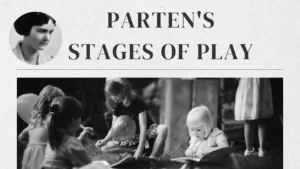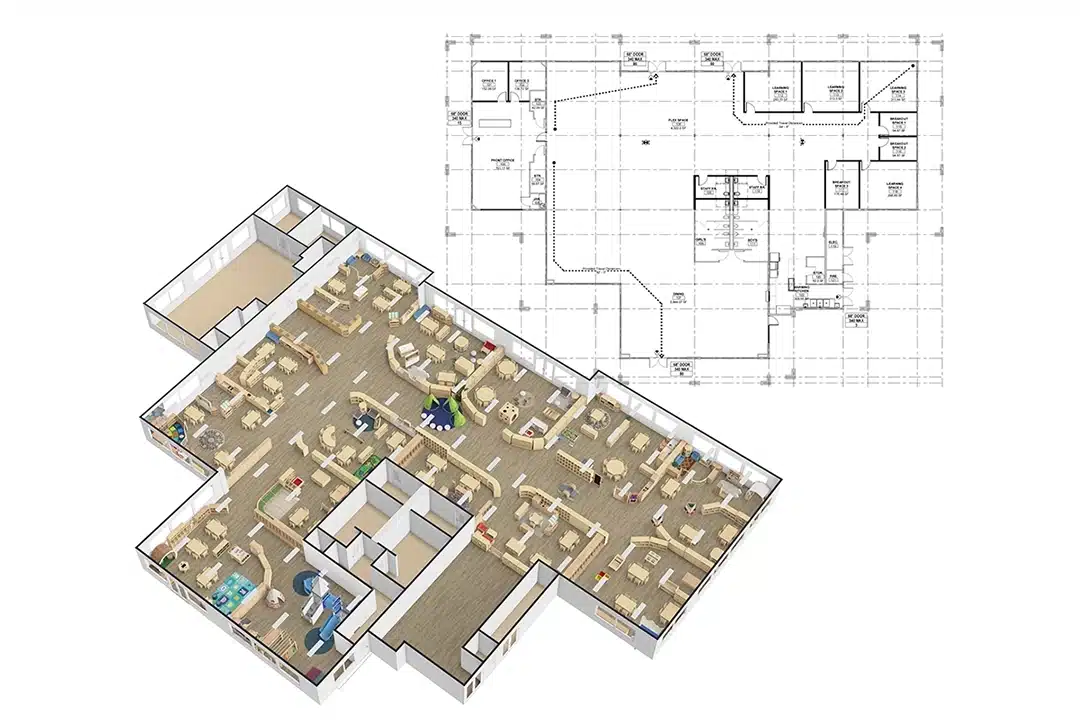Are you wondering how to use learning tower safely at home? Worried that your toddler might fall or misuse it? Unsure whether the tower fits your kitchen space or daily routine? Do you hesitate to introduce one because you’re unclear about the real benefits? Safety and effectiveness are key when we use learning tower with young children, but how can we make sure both are guaranteed?
When used correctly, a learning tower becomes one of the most empowering tools for early childhood development. It allows children to stand safely at adult height, participate in family activities, and explore their environment with confidence. The ability to use learning tower at home helps improve fine motor skills, promotes hands-on learning, encourages responsibility, and builds stronger parent-child relationships. It transforms everyday routines like cooking and washing into joyful learning experiences.
To truly understand how to use learning tower safely and effectively, you need clear steps and everyday tips. Keep reading—I’ll show you how to make it part of your child’s routine so they can stay safe, have fun, and grow more independent at home.
What Is the Learning Tower?
If you’re a kindergarten owner, early childhood educator, or parent seeking practical tools to support child development, the learning tower is something worth knowing. A learning tower is a child-safe, elevated platform that allows toddlers and preschool-aged children to stand at counter height, participate in household tasks, and explore their environment safely. Unlike a regular chair or stool, the learning tower features sturdy railings and a wide base, minimizing the risk of falls. It’s specifically designed to foster independence, confidence, and hands-on learning—key principles in both Montessori and Reggio Emilia classrooms.
In Montessori education, independence is a core value. The learning tower aligns perfectly with this philosophy. It gives children freedom of movement within a safe structure, allowing them to engage in purposeful activity. Whether it’s preparing a snack or pouring water, the child is in control, developing autonomy and confidence.
Whether in a daycare, preschool, or home, the learning tower is both a safety tool and an educational resource. Schools that value child-led learning increasingly choose to include it in classroom kitchens, sensory areas, or art corners. At home, it’s a great way for parents to keep children engaged while staying safe near adult-height surfaces.
So, what is the learning tower? It’s more than just a piece of furniture—it’s a bridge between the child’s world and the adult world, offering security, independence, and meaningful engagement.
Benefits of Learning Tower for toddler
When we use a learning tower in a toddler’s environment—whether at home or in an early childhood classroom—we do far more than give them a step stool. We give them a new way to experience the world, a structured opportunity to be included, and a safe method to participate in daily routines.
Boosts Confidence and Curiosity
One of the most immediate changes you’ll notice when you use learning tower with a toddler is their boost in confidence. Suddenly, they’re no longer looking up at all the action from below—they’re standing at counter height, engaging in the same activities as adults. Whether it’s helping to stir pancake batter, wash vegetables, or pour water, they feel trusted and empowered.
This sense of inclusion naturally fuels their curiosity. Toddlers are born explorers, and the learning tower gives them front-row access to everyday moments that would otherwise be out of reach. They begin asking more questions, trying new skills, and focusing for longer periods. Over time, you’ll notice them taking initiative, reaching for items to participate before being invited, or recalling a task they helped with yesterday. This confidence-in-action supports long-term independent learning habits and lays a foundation for cognitive growth.
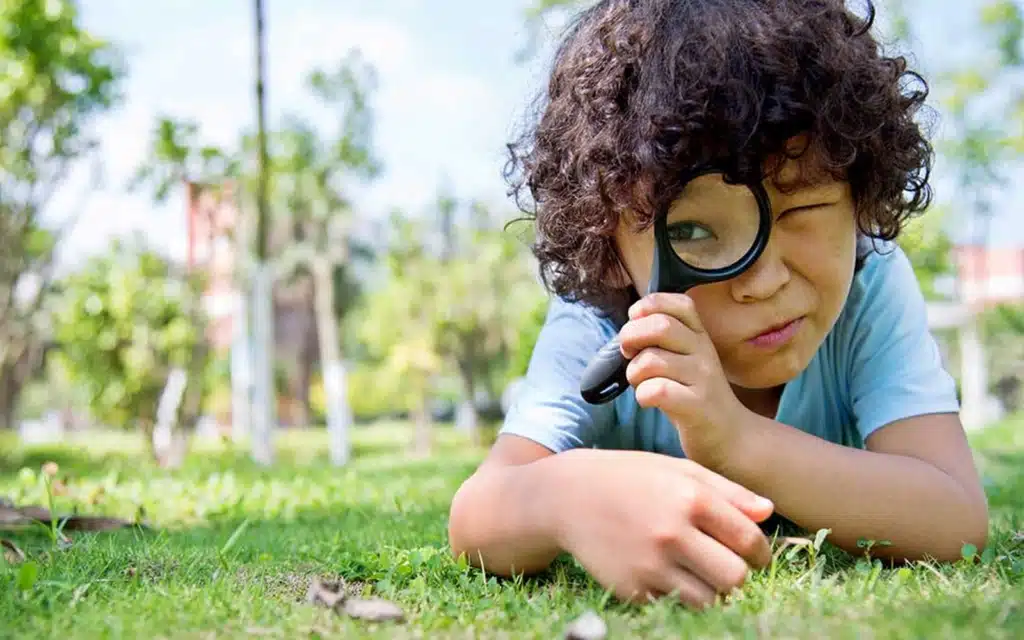
Safety
Unlike a regular stool or chair, which poses fall risks and instability, the learning tower is specifically designed with toddler safety in mind. It features high side railings and a wide, non-slip base to prevent tipping. This means toddlers can safely stand and move within a protected frame, even when they’re excited or distracted.
When you use learning tower regularly, you remove the temptation for toddlers to climb unsafe furniture. You’re offering them a designated tool that satisfies their need for independence without compromising security. For many parents and educators, this alone makes the investment worthwhile. It’s also an excellent solution for busy kitchen environments where a child might otherwise be at risk near hot surfaces or sharp objects. A properly positioned learning tower gives the child access to safe spaces and activities, while adults can supervise with peace of mind.
Learning Made Fun
When you use learning tower in your home or classroom, education happens naturally. Toddlers don’t even realize they’re learning—they’re just having fun. Whether they’re helping wash fruit, scoop flour, or mix dough, they’re developing fine motor skills, coordination, and hand strength.
These practical life tasks also teach patience, sequencing, and the cause-and-effect relationship: If I stir too fast, it spills. If I pour carefully, it works. These are early problem-solving skills that cannot be learned through passive activities like screen time. Most importantly, because the tasks are real and useful, toddlers feel a deep sense of purpose. They aren’t “pretending” to help—they are helping. That real-world application is what makes learning through a tower so meaningful.
In many Montessori classrooms, we integrate the learning tower into baking lessons, dishwashing stations, and plant care routines. Each use turns a simple task into a sensorial and educational experience, keeping the child engaged and building practical skills for life.
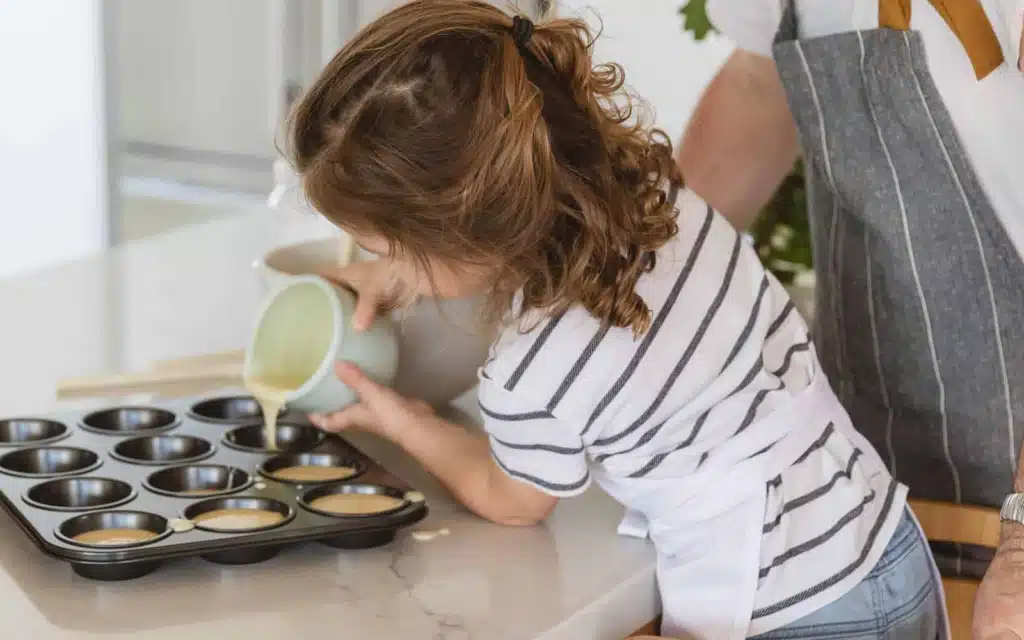
Bonding Experience
One of the most overlooked benefits of using a learning tower is how it enhances bonding between the adult and the child. When you use learning tower with your toddler, you’re no longer doing things for them—you’re doing things with them. You invite them to your level, physically and emotionally.
Daily tasks become shared moments of connection. Cooking breakfast turns into storytelling. Cleaning up becomes teamwork. Even the simple act of preparing a snack becomes an opportunity for conversation and interaction. These shared activities build trust, deepen relationships, and give toddlers a sense of belonging within the family or classroom.
In a world where busy schedules often separate adults and children into different tasks and roles, the learning tower bridges that gap. It creates a space where meaningful interaction happens naturally, without screens or structured activities. That kind of bonding builds emotional intelligence and self-esteem, two qualities that will serve children far beyond their toddler years.
Most Popular Types of Learning Tower for Toddlers
Learning towers come in a variety of styles, each designed to support toddlers safely as they explore and engage in daily tasks. In this article, we break down the most popular types of learning tower, from adjustable wooden frames to foldable models and convertible 2-in-1 options. Whether you’re a parent, preschool director, or daycare owner, understanding the differences will help you choose the best fit for your space and your child’s developmental needs. Discover which learning tower offers the right balance of safety, functionality, and fun for toddlers at home or in an early childhood environment.
Adjustable Height Learning Tower
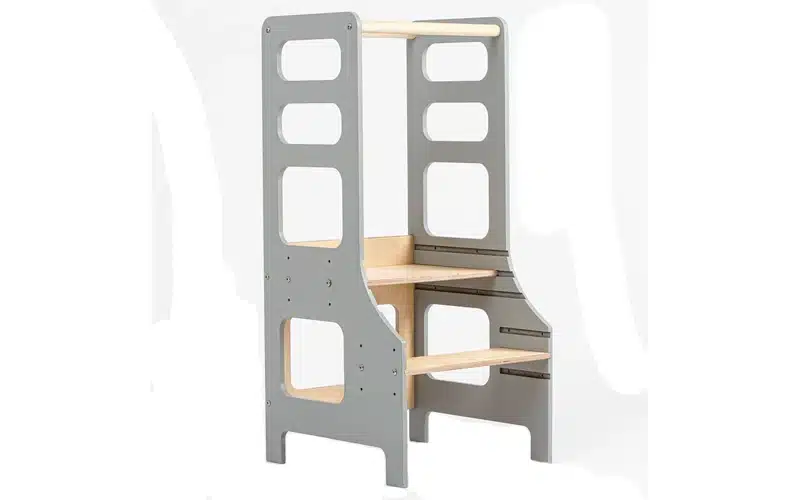
This type of learning tower features a platform that can be adjusted to multiple height levels as your toddler grows. It ensures long-term usability and ergonomic safety, making it ideal for families who want one tower from age 1 to 5.
Foldable Learning Tower
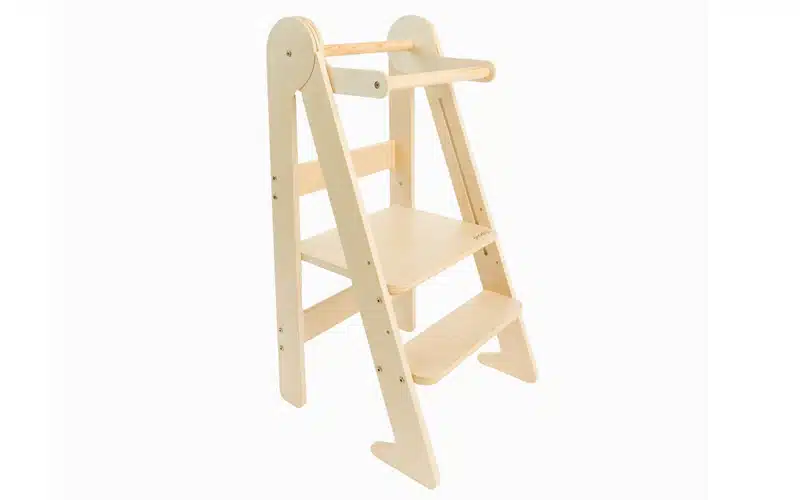
A foldable learning tower is perfect for small spaces. It can be collapsed and stored when not in use, making it ideal for apartments or classrooms with limited storage. Despite its lightweight frame, many are still sturdy and safe.
2-in-1 Learning Tower

These convertible towers transform from a step-up tower into a small table and chair for art or snack time. It combines multiple functions in one piece of furniture, saving space and adding value for both homes and daycares.
Learning Tower with Chalkboard
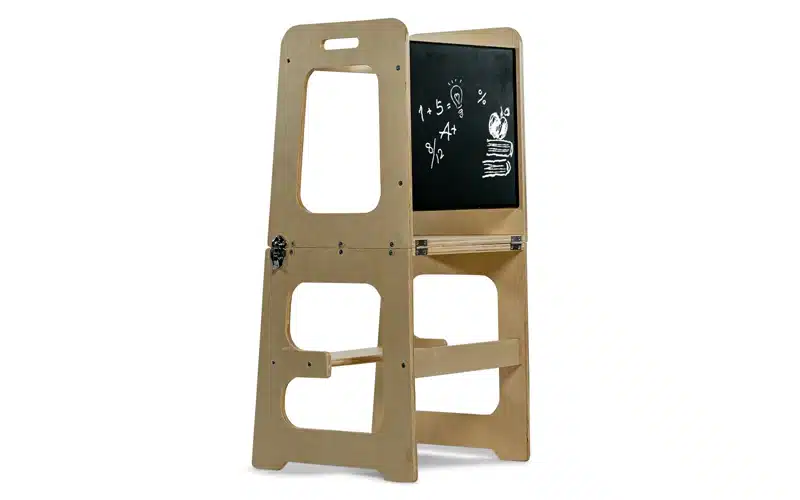
Some towers come with built-in chalkboards, whiteboards, or sensory play panels on the sides. These features encourage creative play when the child isn’t actively using them to stand or help in the kitchen.
Learning Tower with Safety Enclosure
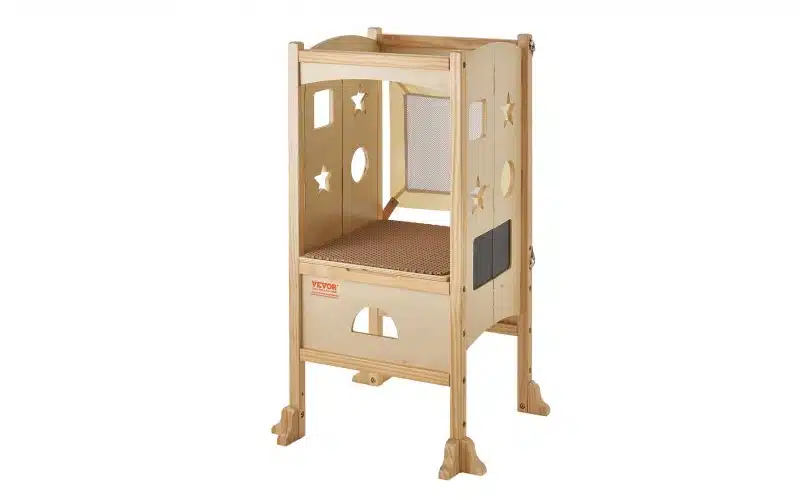
This model features four-sided railings and sometimes a back gate to fully enclose the child. It’s ideal for younger toddlers (12–24 months) or extra cautious parents who want maximum safety during kitchen use.
Plastic Learning Tower
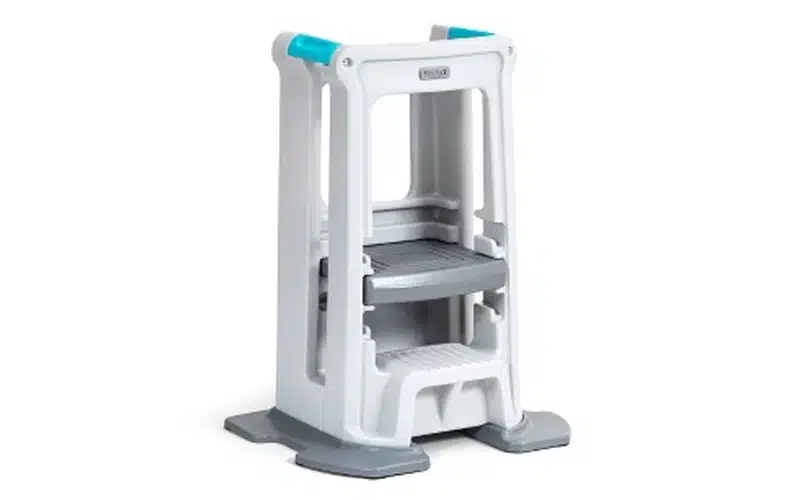
Made from high-quality, child-safe plastic, these towers are easy to clean, lightweight, and often more affordable. While less durable than solid wood, they’re a good fit for indoor-outdoor usage and quick mobility.
Learning Tower with Step Assist
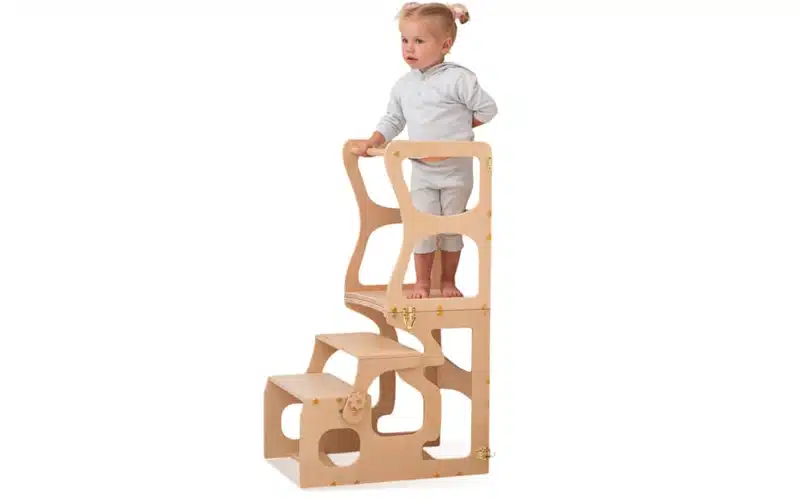
These towers include an extra lower step that helps younger toddlers get in and out independently. It supports the development of balance and motor planning, and is especially useful for 18–24-month-old users.
Twins Learning Tower

Built to accommodate two toddlers at once, this wide-format learning tower is perfect for siblings or classroom environments. It encourages social interaction, shared tasks, and is more efficient for busy group settings.
How to Use Learning Tower?
A toddler tower is one of the most useful tools for toddlers during their early development years. But knowing how to use learning tower the right way is key to ensuring both safety and educational value. This piece of furniture isn’t just a fancy step stool—it’s a gateway to independence, practical life learning, and joyful family interaction. Let’s explore how to set it up, use it effectively, and make it a trusted part of your toddler’s daily routine.
Choose the Right Spot for Setup
Before your child even climbs in, you need to decide where to place the learning tower. For most families, the kitchen is the go-to location. Why? Because it’s where most real-life activities happen: preparing meals, washing fruits, or setting the table. However, placement must be done with caution. Always place the tower on a flat, stable surface away from open flames, boiling pots, or sharp utensils.
Avoid slippery floors, and ensure there is enough space around the tower for both the child and the adult to move freely. The tower should be positioned close enough to the counter or sink so that the child doesn’t have to lean too far forward. When possible, choose a model with adjustable height, so you can modify the platform as your child grows.
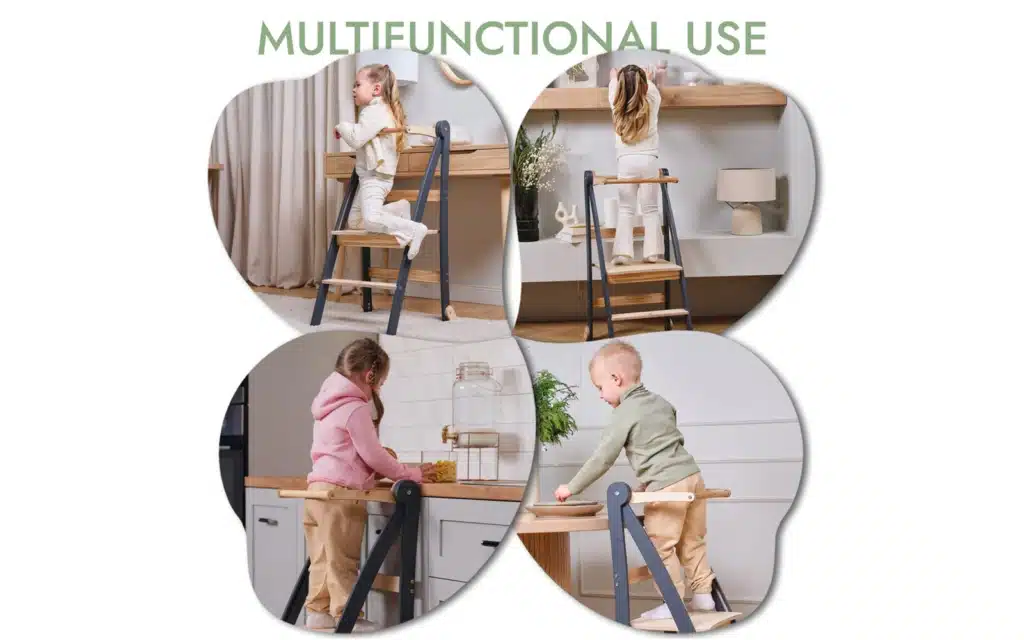
Gradual Introduction Builds Comfort and Confidence
Don’t expect your toddler to jump in right away and start working like a sous-chef. For many children, standing at counter height is a new and unfamiliar experience. The key to learning how to use learning tower is introducing it slowly.
Start by demonstrating how to safely get in and out. Hold their hand the first few times. Talk to them about what the tower is for. “This is your tower. It helps you stand up here with me, safely.” Give them simple tasks to begin with, like rinsing vegetables or handing you a spoon. These small wins help build confidence. As their comfort level increases, you’ll find them asking to use it daily, even for brushing their teeth or washing hands at a higher sink.
Encourage Real-Life Tasks That Teach Responsibility
The true value of using a learning tower lies in its ability to integrate toddlers into real-life routines. This isn’t just play—it’s purposeful learning. Every time your child uses the tower to help in the kitchen, they’re building fine motor skills, understanding cause and effect, and developing a sense of belonging and responsibility.
Here are some examples of daily routines made possible by using a learning tower:
- Pouring their own milk or water from a small jug
- Spreading butter on toast
- Stirring batter for pancakes or muffins
- Washing hands or brushing teeth at a bathroom sink
- Watering plants on the windowsill
- Helping wash non-breakable dishes in the sink
These aren’t just tasks—they’re lessons in coordination, self-control, sequencing, and problem-solving. The more your child participates, the more skilled and independent they become.
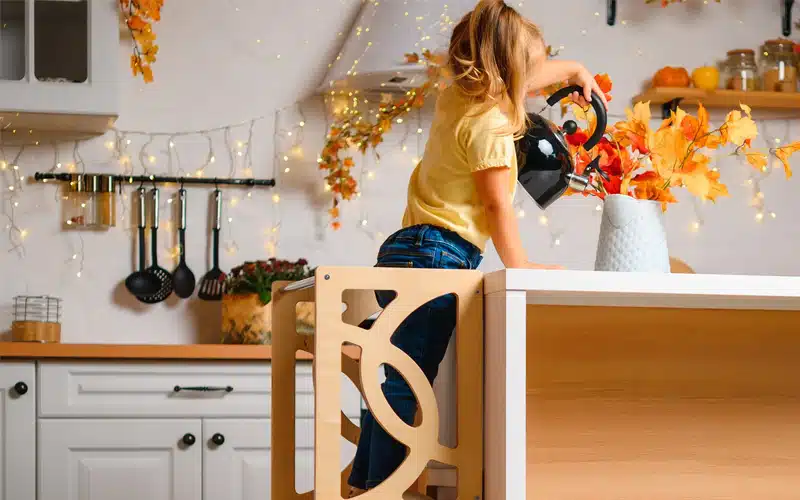
Supervision and Safety
No matter how secure the structure is, a toddler should never be left unattended in a learning tower. Always supervise closely while they are using it. Teach them to climb in and out safely and calmly. Make it a rule that they always ask an adult before using it. If you use a foldable model, ensure it’s fully locked in place. Regularly inspect the screws and frame for looseness or wear.
If you want to go a step further, place non-slip pads under the feet of the tower to prevent shifting, especially on tile or wood flooring. And always position the tower so that your child is facing the task, not turned sideways or backward, which can increase the chance of falling.
Use It Consistently to Build Habits
Like any new tool, the learning tower becomes more powerful when used consistently. The goal is for your child to view it as a regular part of their daily life, not just something special for baking cookies once a month. When you use learning tower during regular routines, children begin to take initiative: climbing in to help without being asked, or pointing out what they want to try next.
Over time, what starts as guided exploration becomes independent action. Your toddler won’t just be standing next to you—they’ll be working with you. That transformation is what makes the learning tower such a valuable part of early education, whether at home or in a classroom.
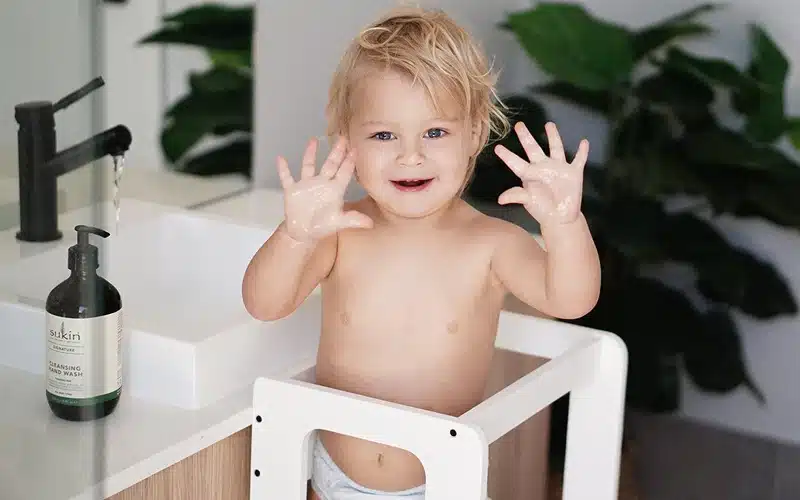
Recommended Activities That Make Learning Fun and Purposeful
transforms ordinary household tasks into rich learning experiences for toddlers. When children stand safely at counter height, they don’t just observe—they engage, participate, and learn with purpose. The key to getting the most out of your learning tower is to integrate it into everyday routines that naturally support motor skills, cognitive growth, and independence.
Here are several recommended activities you can try at home or in the classroom that make learning both fun and developmentally meaningful.
Kitchen Helper Tasks: Cooking as a Learning Laboratory
The kitchen is one of the most dynamic and educational spaces in a home. With a learning tower, toddlers can safely join meal prep and turn basic cooking activities into hands-on lessons. For example:
- Mixing ingredients – Stirring, folding, and pouring develop fine motor control and hand-eye coordination.
- Washing fruits and vegetables – Teaches hygiene, sequencing, and water control.
- Scooping flour or sugar – Offers tactile experience, volume awareness, and practice with tools.
- Peeling bananas or oranges – Builds patience and manual dexterity.
- Plating food – Helps with sorting, patterns, and symmetry.
Every kitchen task has layers of learning. Measuring ingredients introduces math concepts. Observing changes during cooking (like batter turning into muffins) introduces science. Naming vegetables or utensils builds vocabulary. Most importantly, your toddler feels needed—and that emotional engagement amplifies the learning impact.
Cleaning Up: Responsibility
Parents are often surprised to discover how much toddlers love helping clean—especially when they have the right tools and access. With a learning tower, your child can:
- Wash non-breakable dishes in the sink
- Wipe down counters with a damp cloth
- Sort silverware into a tray
- Rinse their own hands and face at the sink
These activities teach responsibility and self-care. They also reinforce routines: children begin to see cleaning not as a chore but as a natural part of life. You can use verbal cues like “Now let’s wash your plate,” to promote consistency. Over time, they’ll initiate cleanup without being asked.
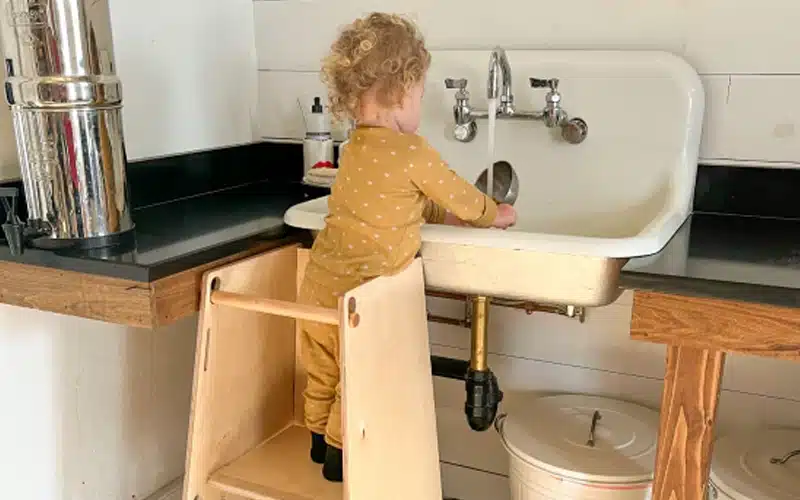
Personal Hygiene Habits: Building Lifelong Skills
Use learning tower in the bathroom opens up opportunities for teaching daily hygiene routines. By placing the tower in front of the sink, toddlers can:
- Brush their teeth independently
- Wash their hands properly
- Rinse their face or comb their hair
These small tasks promote autonomy and create a sense of ownership over personal care. Instead of being lifted by an adult, the child can do it themselves—this shift in control is incredibly empowering. Consistent practice using the learning tower during these moments helps toddlers internalize daily hygiene as part of their responsibility, not just a rule enforced by grown-ups.
Art and Creativity Stations: Encourage Self-Expression
Another great way to use the learning tower is by placing it next to an easel, table, or counter designated for creative play. Art activities are not only fun—they support emotional development and creative problem-solving.
Suggested activities:
- Finger painting or brush painting at counter height
- Color sorting with pom-poms or buttons
- Using cookie cutters and playdough for shape recognition
- DIY crafts like cutting, gluing, and sticking
Being at the same height as their workspace helps children maintain better posture and concentration. Plus, creativity thrives when they have the freedom to move and access their materials independently.
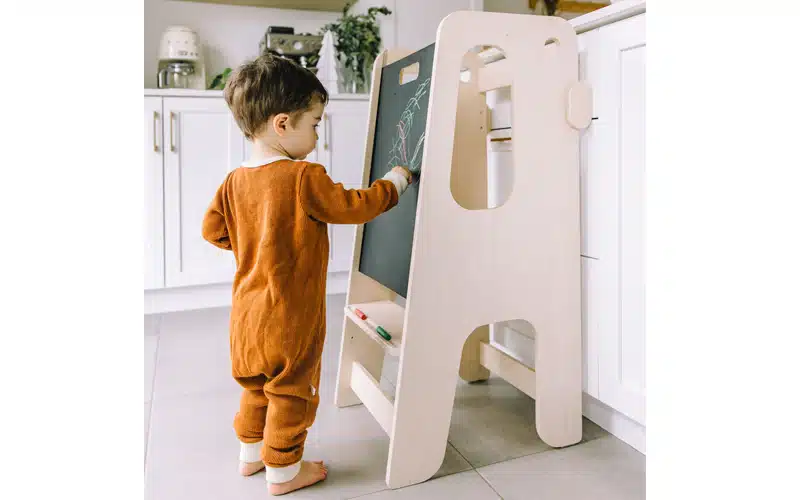
Practical Life Montessori Activities: Real Tasks with Real Tools
In Montessori education, the concept of “practical life” is foundational. When we give children real tasks using real materials, they develop concentration, coordination, and a deep sense of purpose. The learning tower becomes essential in helping toddlers participate in:
- Watering plants on a window ledge
- Filling their own water cup and returning it to the shelf
- Making their own snack (e.g., slicing a banana with a child-safe knife)
- Feeding a pet or organizing a lunchbox
All these tasks encourage decision-making, responsibility, and natural consequences. “If I spill, I clean it.” “If I water the plant too much, it overflows.” These are real-life lessons with long-term benefits.
Safety Tips for Everyday Use
The learning tower is a fantastic tool for promoting independence, confidence, and practical life skills in toddlers. But just like any piece of early childhood furniture, how to use learning tower safely should be the top priority. While these towers are specifically designed with child safety in mind, improper use or lack of supervision can still lead to accidents. That’s why it’s essential to understand not only the benefits of use learning tower, but also the safety rules and practices that should accompany it in daily use.
Always Use Learning Tower Under Supervision
The number one rule when using a learning tower is simple: Never leave your child unattended while they are in it. Toddlers are naturally curious and unpredictable. Even the most well-behaved child might lean too far over the edge, try to climb out the wrong way, or reach for something unsafe on the counter.
Even if you’re only stepping away for “just a second,” accidents can happen in moments. The learning tower is a tool meant to enhance shared activity, not act as a standalone babysitter. Adult supervision ensures that the child stays focused, secure, and safe while engaging in meaningful tasks.
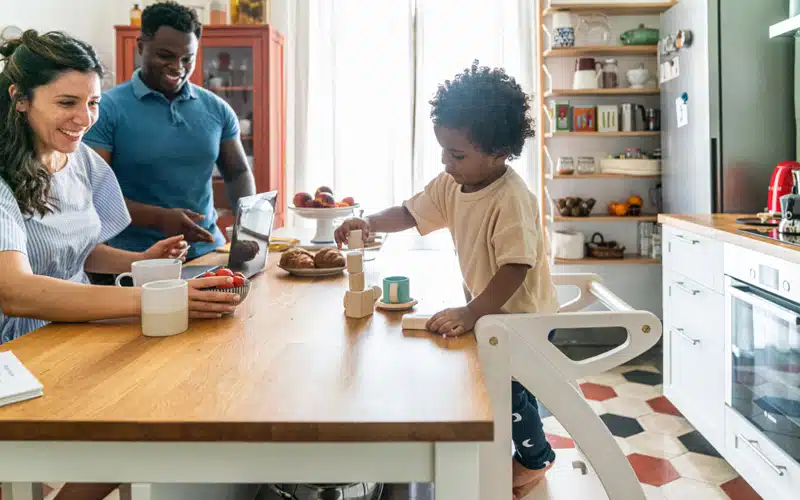
Check the Tower’s Condition Regularly
Like any piece of furniture, learning towers experience wear and tear. Especially if used daily, components can loosen over time. Make it a habit to inspect the tower weekly or bi-weekly for signs of damage.
Checklist:
- Tighten all screws, bolts, and wooden joints.
- Check for splinters or rough edges, especially if it’s made of unfinished wood.
- Test the sturdiness by lightly shaking it before your child climbs in.
- If the tower is adjustable or foldable, confirm that the locking mechanisms are functioning properly.
Routine maintenance not only extends the life of your tower—it also protects your child from preventable injury.
Position the Tower Thoughtfully in High-Use Areas
The most common place to use learning tower is the kitchen. However, it’s also the area with the most safety hazards. When positioning the tower:
- Keep it far from stovetops, hot pots, and knives.
- Avoid placing it near drawers that contain sharp utensils.
- Position it so your child has a clear workspace without needing to reach over dangerous objects.
If the learning tower is being used in the bathroom, make sure it’s away from slippery surfaces, electric appliances, and filled bathtubs. Safety is about environment as much as it is about structure.
Choose the Right Model for Your Child’s Age and Skill Level
Not all learning towers are the same. If you’re using it with a younger toddler (12–24 months), opt for a model with:
- Higher railings.
- Four-sided enclosure.
- Wider base for extra stability.
Older toddlers (2.5+ years) may be able to use towers with more open frames, but safety features should still be present. If the model has adjustable heights, ensure you’re using the right setting for your child’s current height and ability.
For schools or daycares, twin learning towers or enclosed models offer safer group usage where supervision might be shared among multiple children..
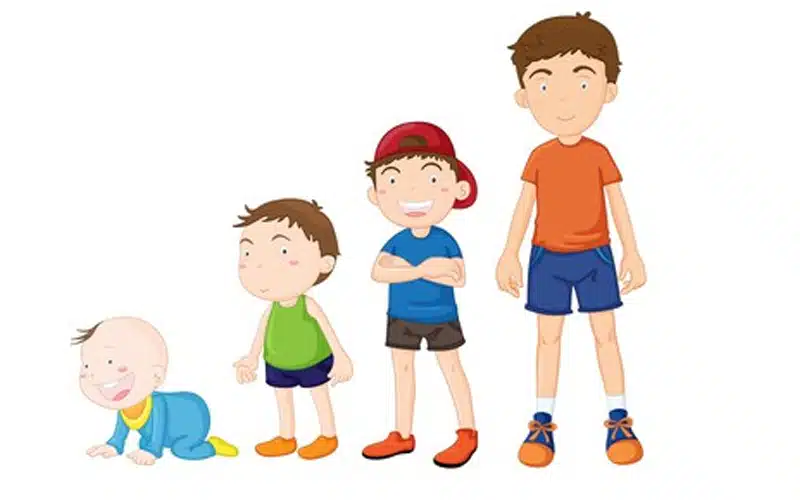
Avoid Overloading the Tower
Most learning towers are designed for one child at a time. Unless you’re using a double-sided or “twin” model, do not allow two children to stand inside the same tower together. Overloading not only increases the risk of tipping but also causes distractions and playful behavior that can lead to falls.
If multiple children want to participate, encourage them to take turns, or invest in a second tower if space allows. Group safety always trumps convenience.
Dress for Safe
It’s a small detail, but what your child wears can affect how safely they use the tower. Loose clothing, slippery socks, or long scarves can all pose risks when climbing or standing at height. To ensure maximum safety:
- Choose grip socks or bare feet.
- Avoid long skirts or oversized pants.
- Tie back long hair and avoid dangling accessories.
The right clothing supports balance and reduces the chance of tripping or slipping while using the learning tower.
FAQs
1. What age can a child safely use learning tower?
Most toddlers can use learning tower safely from around 18 months, provided they can stand steadily and follow basic instructions. For younger toddlers, choose a model with an enclosed frame and supervise closely. Every child develops differently, so observe their coordination before introducing the tower.
2. Where can I use learning tower besides the kitchen?
While the kitchen is the most popular location, you can also use learning tower in the bathroom (for brushing teeth), laundry room (to help sort clothes), or art area. Any space where your child can participate in real tasks is ideal, as long as the environment is safe and supervised.
3. Do I need a learning tower if I already have a high chair?
Yes. A high chair is designed for eating in a seated position. In contrast, when you use learning tower, you give your child a chance to stand, move, and participate in hands-on activities like food prep or cleaning. It supports independence in a way a high chair never can.
4. What features ensure safe and effective use of a learning tower?
To safely use learning tower every day, look for features like:
- A wide, anti-tip base
- Guardrails on all sides
- Adjustable platform height
- Smooth, non-toxic finish
Choosing the right model ensures your child can explore confidently while staying secure during use.
5. How should I clean and maintain the learning tower?
To hygienically use learning tower, clean it regularly with a damp cloth and mild soap. Avoid soaking wooden surfaces. Check for loose screws or sharp edges weekly. A well-maintained tower guarantees safe and long-lasting use in both homes and educational settings.
6. Can I use learning tower in a preschool or daycare?
Absolutely. Many early education centers use learning tower to promote practical life skills in children. When used in a classroom, towers encourage group participation, independence, and hands-on learning. Choose commercial-grade models designed for high-frequency use and certified safety.
7. What if my child isn’t interested in using the learning tower?
To encourage your child to use learning tower more often, integrate it into fun and routine tasks, like stirring batter, watering plants, or washing fruit. Give them age-appropriate jobs they enjoy, and involve them in your activities. This helps build a natural desire to participate.
Conclusion
Knowing how to use learning tower safely and effectively at home is the key to unlocking its full potential. It’s not just a step-up platform—it’s a tool for building independence, encouraging participation, and supporting your child’s natural development. When used properly, it becomes part of your child’s daily routine, turning everyday tasks into meaningful learning opportunities. From the kitchen to the bathroom, from art corners to practical life activities, the learning tower adapts to your space and your child’s needs. Whether you’re a parent, a preschool director, or a buyer sourcing in bulk, choosing the right tower—and using it wisely—can transform how children grow, learn, and connect with the world around them.



